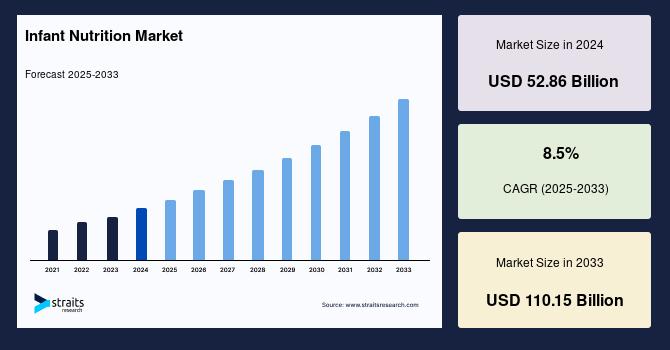Infant Nutrition Market: Sustaining Growth and Nurturing Healthy Futures

The global infant nutrition market size was valued at USD 52.80 billion in 2024. It is projected to reach from USD 57.35 billion by 2025 to USD 110.15 billion by 2033, growing at a CAGR of 8.5% during the forecast period (2025–2033). The market’s growth underscores rising awareness of infant health, evolving parental lifestyles, and advances in nutritional science designed to support optimal early childhood development.
Importance of Infant Nutrition
Proper infant nutrition during the first years of life is crucial for physical growth, cognitive development, and immune function. Balanced nutrition lowers infant mortality and morbidity, helps prevent chronic diseases later in life, and fosters healthy development from birth through early adulthood. Infant nutrition products are formulated to complement or substitute breast milk, providing essential nutrients including proteins, vitamins, minerals, fats, and fluids. While breast milk remains the gold standard owing to its immunological constituents, infant formulas and nutrition products are critical alternatives for infants whose mothers cannot or choose not to breastfeed.
Key Market Drivers
The growing number of working mothers worldwide has been a major catalyst for increased infant formula adoption. Urbanization and changing family dynamics have also elevated demand for high-quality, convenient nutrition products for infants. The proliferation of e-commerce platforms has further expanded consumer access to premium nutritional products, enriched with beneficial additives such as vitamin D, probiotics, and prebiotics, which simulate the protective functions of breast milk microbiota.
Heightened parental awareness about the importance of early nutrition and government initiatives from organizations like UNICEF and WHO reinforce the market’s growth trajectory. These initiatives promote healthy feeding practices and seek to reduce infant malnutrition globally through education and policy.
Product Segmentation and Innovation
Infant formulas remain the backbone of the market and are segmented into first infant formulas and follow-on formulas. First infant formulas, primarily whey-based, are designed for infants up to six months and are formulated to be easy to digest. Follow-on formulas, with a higher casein content, support infants transitioning to solid foods and provide sustained nourishment. Complementing formulas, baby cereals, pureed foods, and fortified milks expand the nutritional variety available to parents, while innovations often incorporate probiotics and prebiotics for digestive health.
Organic and natural infant nutrition products are increasingly preferred by health-conscious consumers aiming to minimize exposure to synthetic chemicals and allergens. The rising demand for organic infant formulas ties into broader sustainability trends, which include environmentally friendly farming practices and cleaner label products.
Regional Market Insights
The Asia-Pacific region leads the infant nutrition market, holding the largest share driven by high birth rates in countries such as China and India, coupled with increasing disposable incomes. The region also experiences rapid urbanization, driving parental demand for premium infant nutrition products. The growing presence of multinational brands expanding into lower-tier cities further accelerates growth.
North America and Europe are established markets with steady growth, largely fueled by higher awareness of nutrition’s role in infant health and lifestyles that often necessitate formula feeding. North America, in particular, sees demand supported by the prevalence of premature births requiring specialized nutrition. Europe’s market benefits from high consumer spending on organic and premium products, with key countries like Germany, the United Kingdom, and France contributing significantly.
Emerging markets in Latin America, the Middle East, and Africa are witnessing increasing demand for tailored infant nutrition products due to economic development, higher birth rates, and rising parental spending power.
Distribution Channels and Consumer Trends
Supermarkets and hypermarkets currently dominate distribution, benefiting from wide product availability and in-store promotions. However, e-commerce is witnessing rapid growth, spurred by greater internet penetration, smartphone adoption, and consumer preference for convenient shopping options. Online platforms also allow brands to provide detailed information on product benefits, nutritional components, and usage guidance, supporting informed purchasing decisions.
Consumers increasingly seek products with transparent sourcing, scientific backing, and clean-label formulations. Demand for personalized nutrition, specialty formulas (such as hypoallergenic or lactose-free), and enhanced sensory experience continues to reshape product development.
Challenges
Regulatory frameworks governing marketing and labeling of infant nutrition products remain stringent in many countries, especially where breastfeeding promotion is a priority. Providers must navigate complex requirements to maintain compliance and consumer trust. Raw material price fluctuations and supply chain disruptions also pose challenges for manufacturers.
Future Outlook
Innovation will be key in advancing the infant nutrition market. Research into probiotic strains, human milk oligosaccharides (HMOs), and bioengineered ingredient enhancements is enabling new generations of formulas that better mimic breast milk’s protective effects. Sustainability considerations, including eco-friendly packaging and organic ingredient sourcing, will increasingly influence market dynamics.
The market segment for organic infant nutrition is expected to experience accelerated growth as consumer preferences shift toward natural and wholesome options. Technological advances in digital health and smart feeding ecosystems may further personalize infant nutrition and foster routine health monitoring.
In essence, the infant nutrition market is evolving rapidly to respond to demographic trends, parental expectations, and scientific progress. Through continuous product innovation and expanded accessibility, this sector plays a pivotal role in ensuring healthier futures for infants globally.
- Art
- Causes
- Crafts
- Dance
- Drinks
- Film
- Fitness
- Food
- Games
- Gardening
- Health
- Home
- Literature
- Music
- Networking
- Other
- Party
- Religion
- Shopping
- Sports
- Theater
- Wellness


